The Big Picture
On the whole, the act of farming and land clearing as currently practised is responsible for 25% of global GHG emissions. But what if farms could sequester significantly more carbon than they emit while producing the staple crops we need?
The second biggest carbon sink on the planet is contained in the top several feet of the earth’s surface – a living, breathing, bio-diverse soil food web where a billion organisms exist in a handful earth. After decades of mining soil carbon*, we have an opportunity to put that carbon back into the soil.
* Compiled data shows that farming practices have resulted in the loss of an
estimated 4.4 billion tons of C from soils of the United States. (http://soilquality.org/)
Here’s the good news: whether you care about carbon sequestration or not, putting carbon back in the soil is a good thing for numerous other reasons. It helps hold more water in the soil, which – as drought pushes food prices ever higher – is good for both farmers and eaters. Holding more water in the soil also significantly lessens the risk of crippling flash floods. (see facts & figure below). The numbers are staggering! Soil carbon also helps hold nutrients in the soil; important for minimizing high-carbon-footprint fertilizer inputs.
Investing in ‘on-farm soil carbon’ is a multi-functional investment that benefits many stakeholders. Compare this strategy to ‘clean-coal’ sequestration projects that, aside from their questionable sequestration performance, provide no other benefits (an unknown negative externalities).
Assumptions
- Abrupt climate change poses a serious risk to food and water security in BC and globally. Flooding and drought are predicted to occur in more extreme waves.
- Billions of federal and provincial dollars are (and will continue to) be spent on climate change adaption and mitigation, including sequestering carbon.
- There are 4.5 million hectares of ALR Land in BC. This does not include other lands that could increase soil organic carbon, like forestry lands.
- A 1 % increase in Soil Organic Carbon (SOC) can sequester as much as 36 tons of C / hectare (14.5 tons of C / acre).**
- If all of BC’s ALR Land increased SOC by 1%; that would mean a gross sequestration of 162 million tons of carbon (minus the carbon cost of achieving this outcome).
- Increasing soil carbon also helps drought-proof farmland. For every 1% increase in SOC*, 144,000 L per hectare of extra water can be store in soil. That’s 56,000L per acre.**
- If all of BC’s ALR Land increased SOC by 1%; that would provide 64 billion litres of extra water storage capacity in the soil, where it belongs (as opposed to flash flooding rivers, valleys, towns and cities). That’s almost half the volume of Sooke Reservoir (Greater Victoria’s water supply), stored on agricultural land in BC.
- There exists a suite of agricultural practices that can increase soil carbon reserves (see below).
- Many of the carbon-sequestering practices (no till farming, silvo-pasture, alley cropping, management intensive grazing) require long-term investment planning or new information, something many farmers are not in a position to invest in.
- Thus, we have a collective investment opportunity that can help stabilize the climate, provide long-term food security and assist farmers in drought proofing their farms.
* Soil Organic Matter (SOM) is 58% Soil Organic Carbon (SOC).
** Dr. Christine Jones. Amazing Carbon
What is Carbon Farming?
Carbon farming is a growing worldwide movement that suggests we can and should increase on-farm carbon reserves (soil carbon + above-ground biomass + below-ground biomass) while producing the food we need to eat.
Eric Toensmeier, in an excerpt from his upcoming book, writes:
There are several, sometimes conflicting, definitions of carbon farming currently in circulation. Most definitions agree that the term refers to farming practices that sequester carbon. Some stop there. For example, here’s such a definition from the Marin Carbon Project: “Carbon farming involves implementing practices that are known to improve the rate at which CO2 is removed from the atmosphere and converted to plant material and/or soil organic matter. Carbon farming is successful when carbon gains resulting from enhanced land management and/or conservation practices exceed carbon losses.”
In other contexts, the term ‘carbon farming’ is intrinsically tied to ‘cap-and-trade’ carbon markets, whereby farmers are paid for carbon sequestered by those industries/companies who are over-emitting.
What’s most important I think, is that we collectively promote and invest in carbon-sequestering agricultural practises however we feasibly can.
What Does Carbon-Sequestering Farming Look Like?
For a summary of some of these techniques, see this blog post by Sheldon Frith on “The 9 Most Important Techniques in Regenerative Agriculture”.
While the biggest carbon-sequestering bang for our buck is found in the tropics, there are great temperate-climate models to follow, like Mark Shepard’s 106 acre perennial polyculture in Viola, Wisconsin – New Forest Farm.
Regardless of the biome, the most effective techniques focus on enhancing biodiversity, minimizing soil disturbance, increasing soil biological activity, stimulating soil nutrient cycles, improving water holding capacity and infiltration – these are the ingredients for topsoil formation and carbon sequestration. Strategies to accomplish this include:
- cocktail cover cropping
- management intensive grazing
- no/minimal till
- the incorporation of tree crops, shade trees & windbreaks
- contour or keyline water management

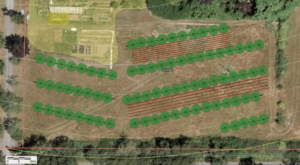
Here in the Capital Region, BC, our business Hatchet & Seed is undertaking a ‘keyline water management’ project that is monitoring ‘keyline cultivation’. This one tool often employed in the ‘carbon farming’ movement to improve topsoil depth and maximize water usage. While our main monitoring metric is volumetric water content (VWC) of the soil profile using moisture probes, we have also collected baseline soil carbon measurements to see if our treatments will improve soil carbon. This is just one small step towards understanding how carbon farming might look in BC, and much more work needs to be done.
Monitoring Soil Carbon?
Monitoring soil carbon represents a significant financial and technical challenge. Measuring net carbon sequestration is a complicated endeavour and there are various methodologies being proposed. The World Bank (Climate-Smart Agriculture) is doing some pioneering work in the area.
As far simply measuring SOC changes, there are various metrics to consider. The standard metrics for soil carbon include Total Organic Carbon (TOC); and Soil Organic Matter (SOM), of which 58% is Soil Organic Carbon. TOC testing is commonly done by taking a sample to the lab and performing combustion tests. Emerging tests use spectroscopy technology that can done in the field.
‘Active carbon’ is another indicator that is good for picking up short-term changes in soil carbon, but it is not as reliable for measuring long-term soil carbon sequestration.
Another challenge is accurately monitoring the carbon footprint of farm activities to achieve ‘net carbon sequestration rates.’ However, there are some estimates we can draw on.
How to invest in carbon farming represents another challenge. Personally, I believe that a ‘carbon tax system’ is more effective than a ‘cap-and-trade system’, which is more common for on-farm carbon credits.
Make no mistake about it, the idea of paying farmers for carbon sequestered has its share of challenges, as this article raises in its critique of efforts already underway in Australia. However, one way or another, getting carbon back in the soil where it belongs represents a solid, multi-functional goal. If paying farmers directly for carbon sequestered turns out to be too troublesome, then providing education outreach and assistance with strategic on-farm tree planting would be a good start.
Net Carbon Sequestration Estimates for Various Agricultural Production Models *
* From Eric Toensmeier’s Webinar, hosted by Project Drawdown.
There is still lots of work being done to properly account for and estimate on-farm carbon sequestration rates. There are sometimes competing views. An overview of these estimates is being compiled in an upcoming book by Eric Toensmeier that I believe will be extremely important for the global movement. Here is a brief summary of the carbon sequestration rates thats Eric has released so far.
0.3 – 0.5 tons/hectare/year for intensive grazing *
0.6 tons/hectare/year conservation tillage agriculture
3.5 tons/hectare/year for orchards & tree crop plantations
2-4 tons/hectare/year for tree-intercropping agriculture
4-7 tons/hectare/year for perennial biomass crops
1-40 tons/hectare/year for multi-strata agroforestry
8-26 tons/hectare/year for intensive silvo-pasture
* Conflicts with estimates for Holistic Planned Grazing from Savory Institute of up to 8 tons / hectare in semi-arid, degraded landscapes.
https://www.nature.com/articles/ncomms7995#supplementary-information
Conclusion
The future of soil carbon reserves is one that deserves serious consideration from policy-makers, farmers, watershed managers, planners, world leaders, scientists and every day citizens. It effects us all.
As Eric Toensmeier says of his upcoming book, I believe our collective goal should be to:
place carbon farming firmly in the centre of the climate solutions platform, steer mitigation funds to the millions of people around the world who are already doing the work, and help ignite a massive movement to transform global agriculture.
Here in British Columbia alone, we could use the added benefits that come with flood and drought proofing our landscapes by raising soil carbon levels.
Additional Resources
- Upcoming book by Eric Toensmeier: The Carbon Farming Solution: A Global Toolkit of Perennial Crops and Regenerative Agriculture Practices for Climate Change Mitigation and Food Security
- Carbon Sequestration in Agricultural Soils. World Bank.
- Carbon That Counts Christine Jones, PhD Founder, Amazing Carbon
- Soil Carbon Sequestration. Food and Agriculture Organization (FAO).
- Increasing Soil Organic Carbon of Agricultural Land. Dr Yin Chan.
- Carbon Farming Gets A Nod At Paris Climate Conference
- The Liquid Carbon Pathway. Dr. Christine Jones.
- Save Our Soils. Dr. Christine Jones.
- Could Carbon Farms Reverse Global Warming. Scientific American.
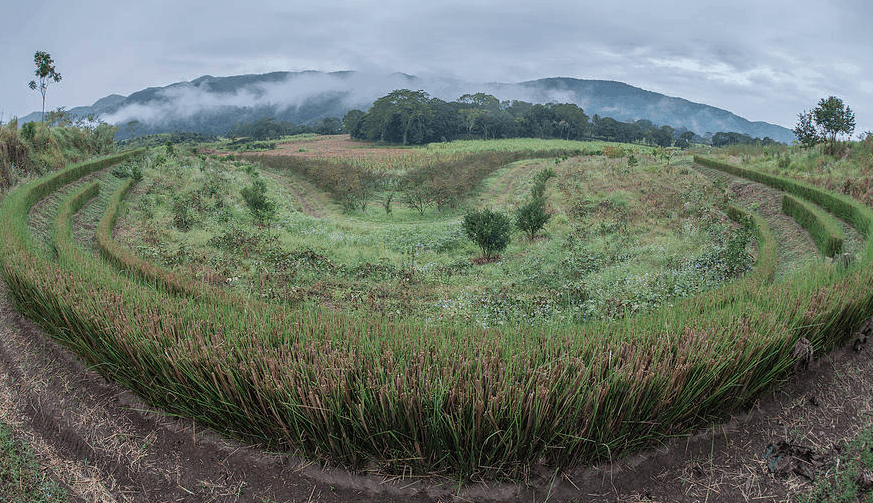 Rancho San Ricardo. A multi-strata keyline agro-forestry farm in Oaxaca State, Mexico.
Rancho San Ricardo. A multi-strata keyline agro-forestry farm in Oaxaca State, Mexico.
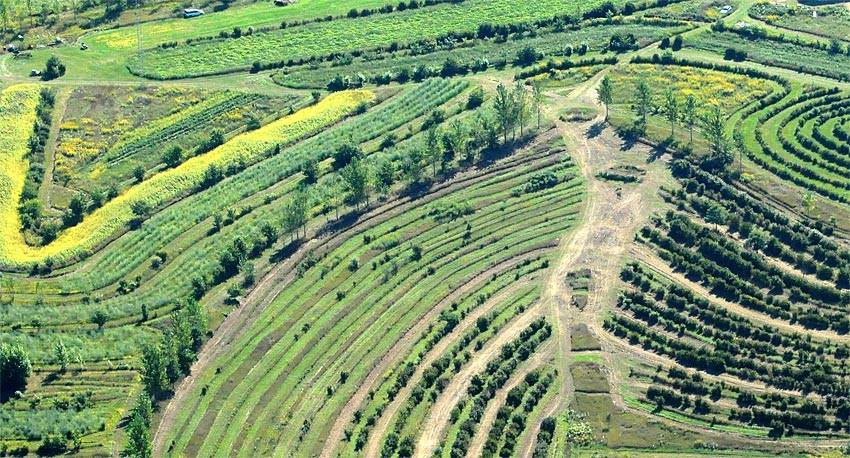 A perennial staple crop and livestock farm in Wisconsin owned and operated by Mark Shepard and his family.
A perennial staple crop and livestock farm in Wisconsin owned and operated by Mark Shepard and his family.
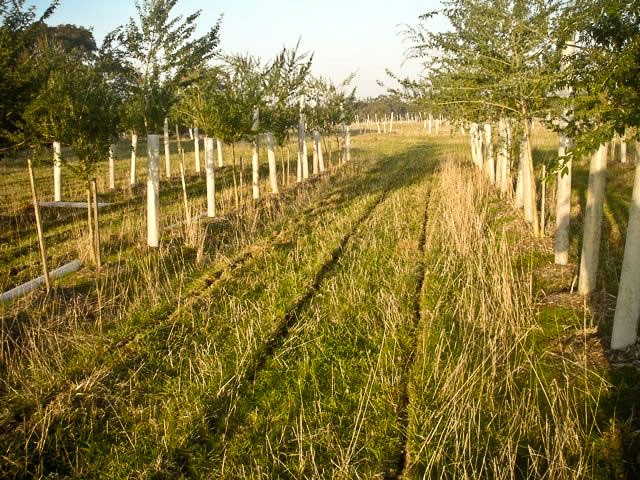 A silvo-pasture layout in Australia. Keyline cultivation between tree rows relieves compaction and deepens the biologically active rhizosphere. Photo credit: Darren Doherty.
A silvo-pasture layout in Australia. Keyline cultivation between tree rows relieves compaction and deepens the biologically active rhizosphere. Photo credit: Darren Doherty.
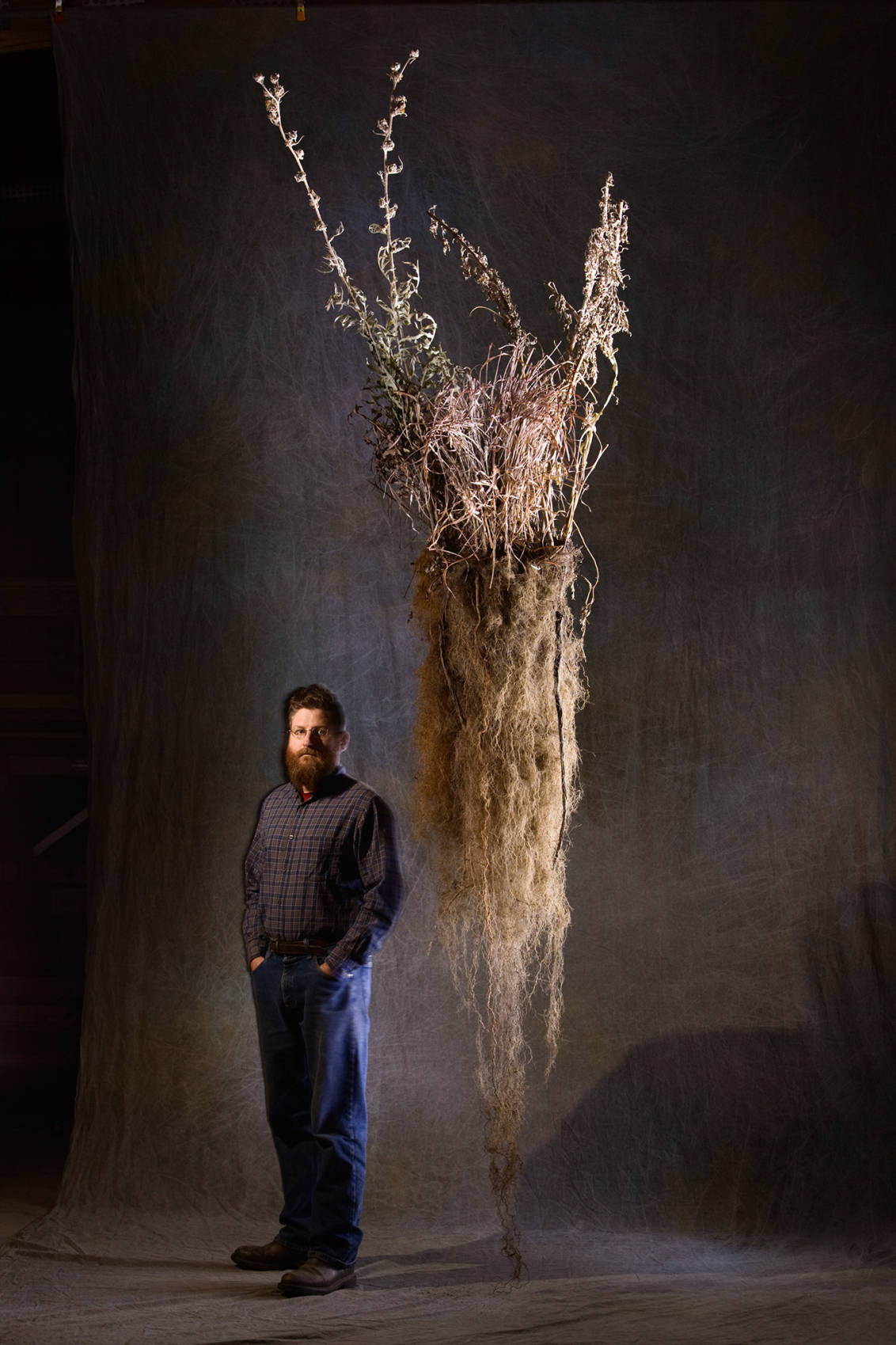 Perennial grasses convert CO2 into carbon-rich sugars and pump them down the root system as much as 20 feet down to feed soil organisms. This is known as the ‘soil carbon pathway’. Photo: National Geographic.
Perennial grasses convert CO2 into carbon-rich sugars and pump them down the root system as much as 20 feet down to feed soil organisms. This is known as the ‘soil carbon pathway’. Photo: National Geographic.
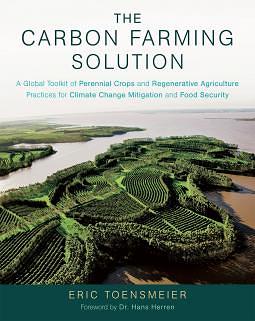
Upcoming book by Eric Toensmeier to be published by Chelsea Green.
Soil Carbon Cowboys from Peter Byck on Vimeo.
A great example of management intensive grazing that mimics the massive herds of bison on tall grass prairie. These herbivores and grasslands are what built some of the deepest soils on earth, and we can rebuild them by mimicking the pattern of heavy grazing and extended rest.
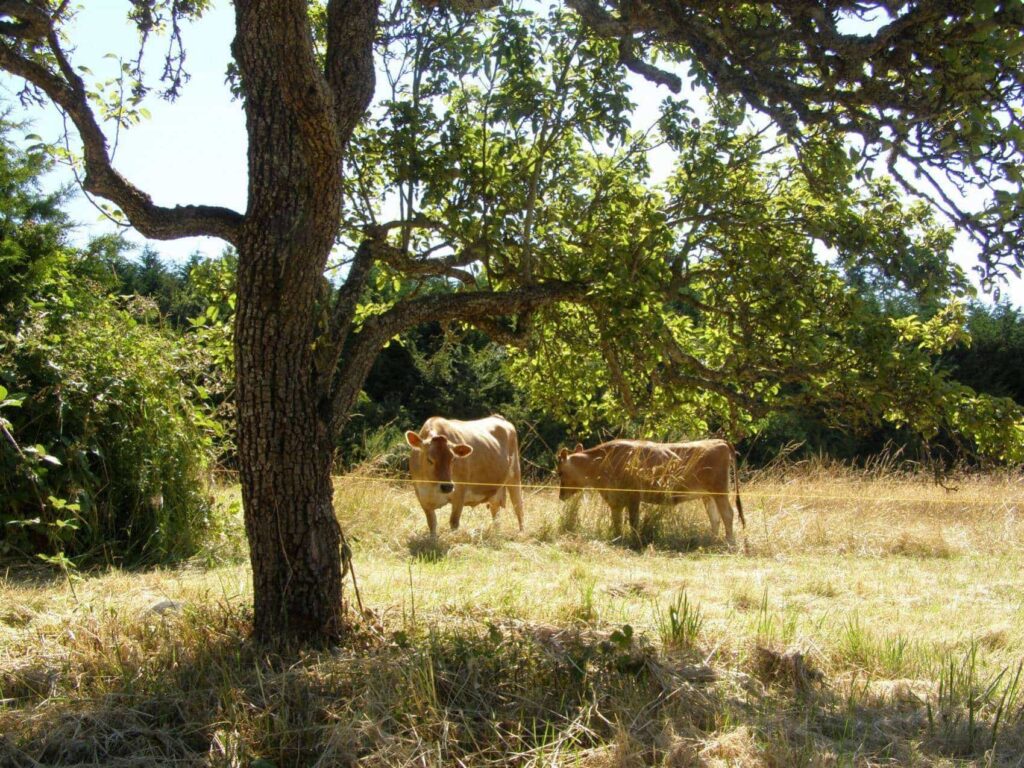

Excellent article Tayler on this important topic.
I suppose we could also look at all the degraded residential lawns and gardens…